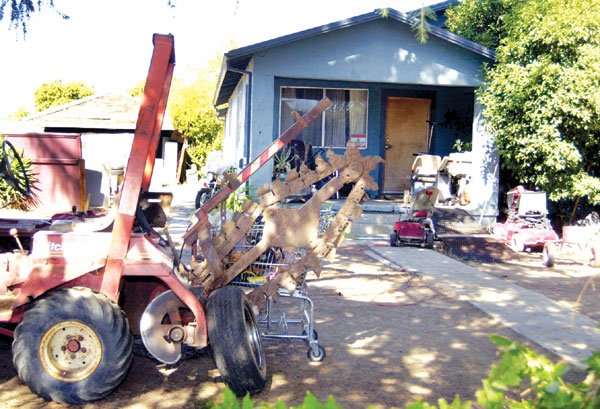Gilroy
– A year after the city passed its blight ordinance, some Gilroy
residents are wondering: What was the point?
A few areas of the city continue to be plagued by a wide variety
of blight: Weeds, trash, large appliances, junk cars and rusty
machinery are among the common complaints.
Gilroy – A year after the city passed its blight ordinance, some Gilroy residents are wondering: What was the point?
A few areas of the city continue to be plagued by a wide variety of blight: Weeds, trash, large appliances, junk cars and rusty machinery are among the common complaints.
After becoming more and more frustrated with the mess in their neighborhood on Ronan Avenue, Jack and Diane Greer approached the city over a year ago asking for a law to target blight.
City council unanimously approved such an ordinance in October of last year. Under the law, Gilroy residents who let rundown vehicles, overgrown weeds or excessive trash accumulate on their front yards could pay up to $1,000 in fines by the city if they don’t clean up their mess. City staff responds to blight violations on a complaint basis only – no patrolling.
Before adopting the ordinance, the city could force people to remove residential eyesores only when they presented health, safety or fire hazards.
While Greer said she’s pleased the city took the first step to cleaner neighborhoods by passing the ordinance, a missing link remains: enforcement.
“I haven’t seen follow up anywhere,” Greer said. “I never see officers out issuing citations. When you have a blight ordinance, you’re supposed to follow up. There are supposed to be officers issuing citations. That’s an important part of it.”
The city brought a dumpster to the neighborhood over a year ago, she said, but that was the last time she noticed any enforcement. Since the ordinance passed, she said she and her husband have called the city several times but never gotten a call back.
Blight has caused property values in her neighborhood to plummet “by $20,000, at least.” She said she hasn’t approached her neighbors because of a language barrier and because she feels that job is better suited for someone with more authority.
“We don’t think we’re better than most people. We just use a broom more often,” she said.
And the issue of blight goes beyond aesthetics, as abandoned cars, tractors, motors, travel trailers, junk and other trash are dripping toxic fluid into the city’s water supply, she said.
Other residents have noticed the problem on Ronan Avenue as well. Every morning when Lordes Ortiz takes her son to Antonio Del Buono Elementary School at 9300 Wren Ave., she sees the blight and “wonders how anyone can live like that.”
Ortiz has lived in her house on Church Street just off Ronan for about a year, and she said the blight problem in the area has not improved.
“We were talking about this just the other day,” said Luly Pacheco, Ortiz’s daughter. “And I was saying, ‘I’m glad we live in a country where the police will do something about this sooner or later.'”
Bill Faus, Gilroy’s planning director, said the city receives up to two calls a day pertaining to residential blight. The calls are directed to one of four staff members who each are in charge of a particular area of the blight ordinance.
Scott Barron, the city’s code enforcement officer, said he keeps a detailed record every time someone calls complaining about residential blight. Staff then will go on a site inspection, and if the property owner is violating the ordinance, staff will issue a warning along with a deadline to clean up the property.
But fines are not issued very often, Barron said, because resources are limited and the citations have to go through court review – a lengthy process that doesn’t give the city very much money in the end, Barron said.
“We’d only want to bring it to court to get compliance from the property owner,” Barron said. “Our policy is to go through a series of notices telling the property owners they’re in violation and telling them we’re going to cite them. With enough warnings, we’ll cite them.”
Barron said there is no standard number of warnings the city issues before administering fines. But that will soon change when a new administrative citation policy goes into effect, Barron said.
The policy, adopted by the city in June, will allow city staff to issue fines on the spot without having to go through the court process, Barron said, much like how police officers administer parking tickets. The policy currently is being reviewed by the city attorney.
“That will make my job much easier,” Barron said. “Right now, I just don’t have the mechanisms to issue citations.”
Until the policy goes into effect, citations most likely will remain sparse, as limited resources make it difficult to follow up on every single complaint – and there are many, Barron said.
“I’d like to say (the problem of blight) is getting better, but there’s only so much we can do,” he said. “I think the city has very good intentions and works very hard, but it’s cumbersome to get compliance sometimes. … Every day we’re getting more calls. But I understand people’s complaints.”
Gilroy police Sgt. John Sheedy helps with the city’s vehicle abatement program. The program is not part of the blight ordinance enforcement but deals with the same basic problem: eyesores.
The city towed 470 vehicles over the past three months, Sheedy said, which breaks down to an average of 156 cars per month or more than five per day.
About 1,880 vehicles have been tagged in the past three months, which means the city issued a notice on the cars that they will be towed in 72 hours if not moved. About 75 percent of the tagged cars were moved.
“It’s everywhere,” he said. “A significant portion of them are just junk cars that have been left by their old owner. The city foots the bill on that.”
Technically, the city can tow a car 72 hours after it has been tagged, Sheedy said, but that doesn’t mean it automatically will be towed.
“First we’ll try to contact the owner of the car,” Sheedy said. “Our goal is to solve the problem. We’re not happy towing away every car we tag. The less we tow, the better we prefer.”
What is blight?
Any of the following that is stored on any portion of the front yard of a property except on a paved area for more than 72 hours:
• A boat or motor vehicle, including RVs, whether operable or inoperable
• Miscellaneous items such as refrigerators, washing machines, stoves and heaters
• Solid waste or refuse that piles up if it is visible from a street or public right of way
• Excessive weeds or unkempt brush
Violations:
• First violation: $100
• Second violation: $200
• Third violation: $500
• Each additional violation: misdemeanor punishable by a fine of up to $1,000
To report blight, call City Hall at 846-0400.












